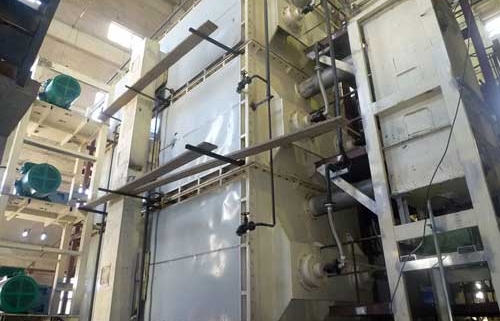los secador de paleta hueca consists of two blade shafts that mesh with each other, a W-shaped casing with a jacket, a machine base and a transmission part. The entire drying process of the sludge is carried out in a closed state, and the organic volatile gas and the odor gas are It is sent to the exhaust gas treatment device in a sealed atmosphere to avoid environmental pollution.
El secador utiliza vapor, agua caliente o el aceite de transferencia de calor como medio de calentamiento, and the shaft end is equipped with a rotary joint for introducing and exporting the heat medium. El medio de calentamiento se divide en dos trayectorias, respectively entering the jacket of the dryer casing and the inner cavity of the blade shaft, heating the body and the blade shaft at the same time, and heating and drying the sludge by conduction heating.
The dried material is continuously and continuously fed into the dryer feeding port by the screw feeder. After the material enters the blade, el material se volvió y agitó por la rotación de la cuchilla, and the heating interface is continuously changed, and the body and the blade are in contact with each other. Heating to evaporate the surface moisture contained in the sludge. Al mismo tiempo, the material is conveyed in the direction of the discharge port with the rotation of the blade shaft in a spiral path, y se continúa la agitación durante el transporte, de manera que el agua que rezuma de los lodos continúa evaporándose. Luego, el producto secado uniformemente se descarga desde el puerto de descarga.
Caracteristicas
1. The equipment is compact in structure and the device covers a small area. Se puede observar a partir de la estructura del dispositivo que el calor necesario para el secado se proporciona principalmente por la superficie de pared de pala hueca dispuesta en el árbol hueco, y la cantidad de transferencia de calor de la superficie de la pared de la chaqueta es sólo una pequeña parte. Por lo tanto, the heat transfer area per unit volume of equipment is large, que puede ahorrar huella de los equipos y reducir la inversión de capital;
2. tasa de utilización de alta temperatura. The paddle dryer is heated by conduction heating, and all heat transfer surfaces are covered by materials, which reduces heat loss; no air takes away heat, and the heat utilization rate can reach 80% o más;
3. La hoja en forma de cuña tiene la capacidad de auto-limpieza, which can improve the blade conduction. La fuerza de dispersión generado por el movimiento combinado de la superficie inclinada de la cuchilla giratoria y la capa de partículas o de polvo hace que el material unido a la rampa de calentamiento a ser eliminado automáticamente, y la hoja mantiene una función de transferencia de calor eficiente. Adicionalmente, debido a la rotación inversa de las cuchillas de dos ejes, the alternating section compression (when the two-axis blade faces are close together) and the expansion (when the two-axis blade faces are far apart), the heat transfer is uniform and the heat transfer is uniform. Heat transfer effect;
4. Since no gas is needed for heating, only a small amount of gas is needed to take away the humid air. The gas velocity in the dryer is low, y el polvo emitido por el gas es menos, and the gas dust recovery of the system after drying is convenient;
5. The material moisture content has wide adaptability and the product has uniform drying uniformity. El secador está provisto de un rebosadero, which can adjust the residence time of the material in the dryer according to the nature of the material and the drying conditions to meet the requirements of the moisture content change of the material. Adicionalmente, la velocidad de alimentación, the rotational speed of the shaft, and the temperature of the heat carrier can be adjusted, and the residence time can be arbitrarily selected between several minutes and several hours. Por lo tanto, the adaptability to the change of moisture content of materials is very wide;
6. The feeding adopts the shaftless screw conveyor, which can transport the muddy materials with high viscosity and high moisture content;
When selecting a paddle dryer, the following factors are mainly considered.
1. Heat source, heat transfer medium and heat loss
The expenditure on drying heat accounts for 60% a 75% of the operating cost of the drying system, or even higher. Por lo tanto, the study of heat source selection and reduction of heat loss is the top priority for the evaluation of the blade dryer drying system.
2. Seguridad
A certain amount of dust will be generated during the hot drying process of the sludge. When the dust reaches a certain concentration, and the oxygen content and temperature are satisfied, explosion or deflagration may occur. Dust explosion accidents are not uncommon at home and abroad, and should be given enough attention.
3. Impact on the environment
In the process of drying, the sludge not only produces odorous gases such as ammonia gas and hydrogen sulfide, but also toxic substances such as benzene, phenol and corresponding compounds. In the process design, the volatilization of these substances should be reduced as much as possible, and the volatilized gas should be properly disposed to avoid gas leakage.



